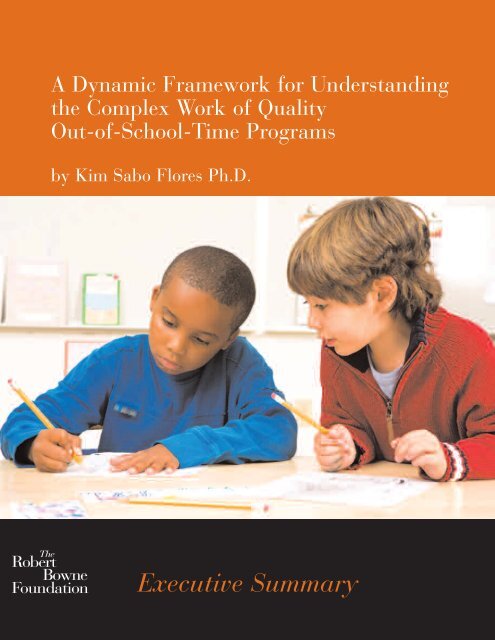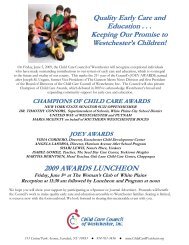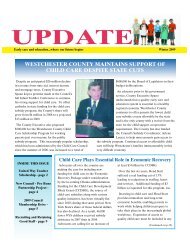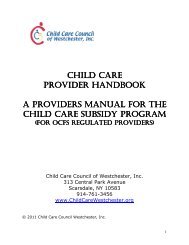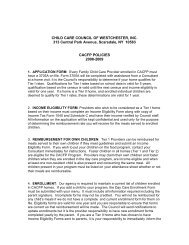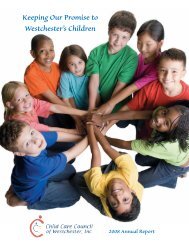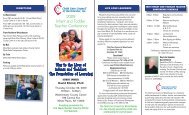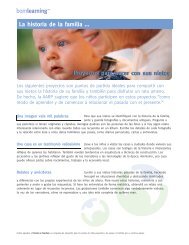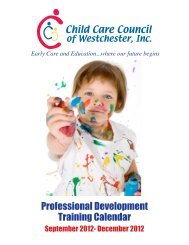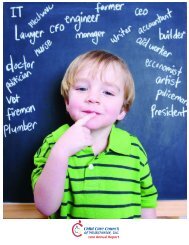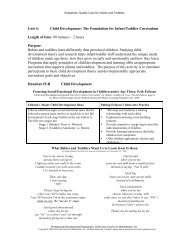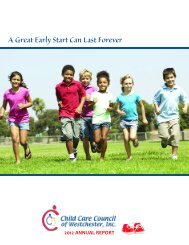Executive Summary - The Robert Bowne Foundation
Executive Summary - The Robert Bowne Foundation
Executive Summary - The Robert Bowne Foundation
Create successful ePaper yourself
Turn your PDF publications into a flip-book with our unique Google optimized e-Paper software.
A Dynamic Framework for Understanding<br />
the Complex Work of Quality<br />
Out-of-School-Time Programs<br />
by Kim Sabo Flores Ph.D.<br />
<strong>The</strong><br />
<strong>Robert</strong><br />
<strong>Bowne</strong><br />
<strong>Foundation</strong><br />
<strong>Executive</strong> <strong>Summary</strong>
Acknowledgements<br />
We would like to thank the staff of all of the programs that participated in this project during<br />
several phases and, especially, the executive directors and staff of the Coalition for Hispanic<br />
Family Services, New Settlement Apartments, New York Hall of Science, Riverdale Neighborhood<br />
House and Stanley Isaacs Neighborhood Center. We would also like to thank the children, youth<br />
and families of the programs.<br />
A special thanks also to the editors Kathleen Ellis and Jan Gallagher who asked all the right<br />
questions and brought clarity and continuity to the project and to Daniella van Gennep for her<br />
unique design and infinite patience.<br />
And, finally, this work also could not have been done without the insight and curiosity of the Learning<br />
Community—the staff and consultants of <strong>The</strong> <strong>Robert</strong> <strong>Bowne</strong> <strong>Foundation</strong> including Lena Townsend,<br />
Anne Lawrence, Sara Hill, Kim Sabo-Flores and Pamela Little.<br />
<strong>The</strong> <strong>Robert</strong> <strong>Bowne</strong> <strong>Foundation</strong><br />
<strong>The</strong> <strong>Robert</strong> <strong>Bowne</strong> <strong>Foundation</strong> supports quality out-of-school time programs that support the literacy<br />
development—engagement in reading, writing, listening, and speaking in order to better understand<br />
oneself, others, and the world—of children and youth in New York City especially for those living in economically<br />
disadvantaged neighborhoods. We do this through direct service grants as well as grants for<br />
programmatic and managerial technical assistance, evaluation, advocacy, research and publications.<br />
Kim Sabo Flores Ph.D.<br />
Dr. Kim Sabo Flores is a seasoned evaluation consultant and leader in the emerging field of youth<br />
participatory evaluation. Drawing upon her training in developmental and environmental psychology,<br />
Dr. Flores introduces hundreds of adults and young people, their programs and their communities to<br />
the empowering impact of creative and sustained participation, reflection and evaluation. In addition,<br />
she has worked with numerous foundations to help build their evaluation capacities, supporting them<br />
to measure their “community” impacts and progress toward achieving their missions. Her unique<br />
approach highlights the performatory nature of participatory evaluation and the contribution of<br />
performance to human learning and development. As founder and principal of Kim Sabo Consulting,<br />
Dr. Flores generates collaborative projects that educate not only program staff but also their funders<br />
about ways that participatory evaluation can help to build organizational capacity.<br />
1
In 2002, the <strong>Robert</strong> <strong>Bowne</strong> <strong>Foundation</strong> set out on what became a five-year journey to answer the following<br />
research question: What are the keys to developing quality out-of-school-time programs<br />
Research Methods<br />
In order to explore these questions of quality, the foundation created a community of learners. <strong>The</strong> members<br />
of the learning community conducted literature reviews, participated in the research design to identify<br />
best practices, and helped analyze and reflect upon the data.<br />
<strong>The</strong> Learning Community pinpointed current and past <strong>Robert</strong> <strong>Bowne</strong> <strong>Foundation</strong> grantees that exemplified<br />
these best practices. Using an independent rating scale, each community member ranked sixty programs<br />
on each of the quality practices that had been established. <strong>The</strong> community identified twenty<br />
programs that we considered high quality.<br />
However, after deeper consideration the members of the learning community realized that while several<br />
of these programs had quality practices, they did not have strong organizational infrastructures. This realization<br />
led the committee to undertake another study, exploring the question: “What is the relationship<br />
between high quality programming and high quality organizations”<br />
In Phase I of the study, a broad range of organizational effectiveness measures were reviewed by the<br />
community members and a new instrument was developed to meet the specific needs of the population.<br />
Next, the twenty current and former grantees that had previously been identified as having “quality programs<br />
and practices” were rated on a scale from one to five (with five being the highest rating) on these<br />
key programmatic and organizational effectiveness indicators.<br />
In September 2002, the nine organizations identified as “effective” were invited to participate in an extensive<br />
in-depth study that focused on their organizational capacities in the identified core areas.<br />
2<br />
During this first phase, an intriguing question came up. <strong>The</strong> data showed that all of the programs were<br />
doing quality work in most of the organizational capacity areas being researched. Indeed, they exhibited<br />
most of the traits defined as “quality” both by the literature and by RBF stakeholders. <strong>The</strong> members of<br />
the community were led to make statements like “Yes, they have a strong mission statement”; “Yes, they<br />
hire qualified staff”; “Yes, they have staff meetings.” But it was clear that key philosophies and approaches<br />
to human development were the glue that held these “promising practices” together. For example, the<br />
key leaders in the program tended to have very similar philosophies of human and youth development<br />
and were equally committed to the development of the staff and the youth as they were the organization.<br />
<strong>The</strong> learning community felt strongly that further exploration was needed in order to answer the question:<br />
what is the relationship between these philosophies and promising organizational practices Thus, we<br />
launched Phase II of our study.<br />
Phase II Methods<br />
Phase II of the research included a more thorough examination of professional development and organizational<br />
learning practices. <strong>The</strong> members of the learning community felt it was important to look outside<br />
the standard paradigms used to understand out-of-school-time programs and to explore new models and<br />
paradigms of success. <strong>The</strong> methodological instruments for Phase II were designed using Peter Senge’s<br />
five disciplines of a learning organization as articulated in his books (e.g., <strong>The</strong> Fifth Discipline, 1990).<br />
<strong>The</strong>se five disciplines include: (1) systems thinking, (2) personal mastery, (3) mental models, (4) building
shared vision, and (5) team learning. Both RBF staff and stakeholders considered these five disciplines<br />
to be an important framework for understanding ongoing organizational learning.<br />
Key Findings<br />
This five-year study yielded six very important findings, outlined briefly below:<br />
Finding 1 – Learning organizations and social cultural learning theory: Organizations that were delivering<br />
high quality literacy programming and were identified as having strong components of organizational<br />
effectiveness were also “learning organizations.” In other words, they had practices that mirrored all five<br />
of Senge’s learning organization disciplines. However, not one of the key leadership team members had<br />
ever heard the words “learning organization,” nor did they know of Peter Senge. Instead, leaders in the<br />
organizations were using their knowledge of youth development and social cultural learning theory not<br />
only to develop programs for the young people, but as principals<br />
for the growth and development of their organizations<br />
and staff members.<br />
Figure 1: Qualities of Developmental<br />
Out-of-school-time Programs<br />
Because these organizations were not directly using learning<br />
organization theory in their work, the constructs, while related<br />
and relevant, did not map directly onto the observed practices.<br />
Within the case study contexts there were six unique<br />
strategies that were employed: A systemic understanding of<br />
development that focused simultaneously on the growth of<br />
the organizations, programs, staff, and youth; shared thinking,<br />
critical discourse and reflection; ongoing team building;<br />
staff members being related to and given the responsibility of<br />
acting in advance of their own development; and a safe environment<br />
in which risks were being taken (Figure 1).<br />
Finding 2 – Creative programs that are continuously created<br />
and evaluated: One ongoing challenge of out-of-school-time<br />
programs has been program stagnation. In many instances,<br />
programs offer the same activities from year to year and students<br />
become bored with the offerings. However, within<br />
these case study programs, activities were created based on<br />
the ongoing development of staff members’ interests, capacities,<br />
and skill levels, and on feedback provided by children<br />
and families through evaluation efforts.<br />
Systems thinking – <strong>The</strong> activity of thinking and operating systematically<br />
to comprehend and address the whole organization as<br />
a dynamic process or creative ensemble rather than in terms of<br />
its individual parts.<br />
Shared thinking, critical discourse and reflection – Ongoing<br />
practices in which staff experience themselves as “performers”<br />
and “creators of life scenes.”<br />
Building the team – Continuously building the team or “growing<br />
the group.” Staff members engage in the joint activity of creating<br />
the team in order to learn, to grow, to give help, to get help and to<br />
create culture.<br />
Relating to staff in advance of their own development –<br />
Relating to all staff members in advance of their own development,<br />
as learners, as development experts, as individuals who can<br />
do anything they desire.<br />
Creating safe environments in which risks can be taken –<br />
Safe environments created by the group activity in which all<br />
members feel comfortable to take risk, to do more than they<br />
thought they could, to perform in new roles.<br />
Because these organizations had strong integrated evaluation and monitoring practices, many decisions<br />
were based on real data. Thus, programs were able to continuously meet the needs of the families and<br />
communities they worked with. In this way, all participants were recipients of innovative, highly creative<br />
and passionate programming.<br />
Finding 3 – High levels of staff satisfaction: Since staff members felt part of creating the programs, and<br />
because they themselves were supported to learn and grow, they reported high levels of personal fulfillment.<br />
Because of their ongoing reflections and evaluations, staff members were able to see and under-
stand their impacts on the children and communities in which they worked. <strong>The</strong>y understood their work<br />
as valuable and meaningful contributions, which they found fulfilling. This finding seems particularly<br />
important given that many out-of-school-time staff are underpaid. Even though many staff members work<br />
in the field because they believe their work is meaningful, all too often they do not have the opportunity to<br />
see the impacts of their unique contributions.<br />
Finding 4 - Low staff turnover. In out-of-school-time programs one of the greatest challenges has been<br />
staff turnover. Often, programs cannot retain staff due to low wages and the fact that staff members are<br />
often very young and are in highly transitional stages of their lives. However, staff members in these case<br />
study programs stayed in their jobs for an average of five years.<br />
Finding 5 – Highly trained and creative staff: A major challenge of out-of-school-time programs has been<br />
their ability to hire competent and educated staff members. In these five case study programs, staff<br />
members were exceedingly well trained and competent. <strong>The</strong>y were engaged in ongoing professional<br />
development opportunities that challenged them to grow while building on their unique talents and<br />
assets. In addition, many staff members were supported by the organization fiscally, practically and emotionally<br />
to obtain their BAs and masters degrees while working in the programs.<br />
Finding 6 – Sustainable organizations: While many factors support the sustainability of an organization, it<br />
should be noted that all of the case study sites had a long history within New York City. This point is particularly<br />
salient because at the time of this study, many community-based organizations in New York City<br />
were closing due to lack of funding or an inability to make the changes necessary to stay open during<br />
massive changes in funding streams. <strong>The</strong> case study programs were able to remain nimble in their<br />
efforts, gathering information, developing staff, creating new programs and evaluating their successes.<br />
Conclusion<br />
4<br />
<strong>The</strong> value of this work lies not so much in what staff members create (i.e., vision statements, mission<br />
statements, curricula, activities, safe environments, etc.), but in the processes by which they create. In<br />
other words, it is not only the existence of a vision and/or mission statement, but the co-creation and participatory<br />
methods of actualizing these statements with staff through ongoing activities that make these<br />
programs high quality. It is not only the knowledge that is produced during staff meetings, but the activity<br />
of producing knowledge. It is not only the social roles that are being played, but the environment that<br />
needs to be produced in order that staff members feel safe to take risks and perform “a head taller.” It is<br />
not only the quality of the curricula and activities that are produced, but the process of developing the<br />
curricula and activities. It is not only the number and type of available professional development activities,<br />
but the ways in which staff members are supported to grow and learn and are related to as learners. It is<br />
not only the existence of a safe environment, but the process of creating a safe environment.<br />
While we have learned much about these unique developmental environments, there are still many questions<br />
to be answered. For example: How can organizations be supported to build these types of environments<br />
Can all organizations create this type of environment, or is a particular type of leadership needed<br />
Is the size of the organization a factor in the development of these types of learning practices Are youth<br />
outcomes different or more intense in these types of environment If we are to more fully understand the<br />
value of these environments, these questions need to be addressed.


